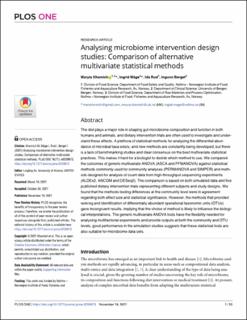| dc.contributor.author | Khomich, Maryia | |
| dc.contributor.author | Måge, Ingrid | |
| dc.contributor.author | Rud, Ida | |
| dc.contributor.author | Berget, Ingunn | |
| dc.date.accessioned | 2021-12-09T08:55:30Z | |
| dc.date.available | 2021-12-09T08:55:30Z | |
| dc.date.created | 2021-12-07T10:46:07Z | |
| dc.date.issued | 2021 | |
| dc.identifier.issn | 1932-6203 | |
| dc.identifier.uri | https://hdl.handle.net/11250/2833518 | |
| dc.description.abstract | The diet plays a major role in shaping gut microbiome composition and function in both humans and animals, and dietary intervention trials are often used to investigate and understand these effects. A plethora of statistical methods for analysing the differential abundance of microbial taxa exists, and new methods are constantly being developed, but there is a lack of benchmarking studies and clear consensus on the best multivariate statistical practices. This makes it hard for a biologist to decide which method to use. We compared the outcomes of generic multivariate ANOVA (ASCA and FFMANOVA) against statistical methods commonly used for community analyses (PERMANOVA and SIMPER) and methods designed for analysis of count data from high-throughput sequencing experiments (ALDEx2, ANCOM and DESeq2). The comparison is based on both simulated data and five published dietary intervention trials representing different subjects and study designs. We found that the methods testing differences at the community level were in agreement regarding both effect size and statistical significance. However, the methods that provided ranking and identification of differentially abundant operational taxonomic units (OTUs) gave incongruent results, implying that the choice of method is likely to influence the biological interpretations. The generic multivariate ANOVA tools have the flexibility needed for analysing multifactorial experiments and provide outputs at both the community and OTU levels; good performance in the simulation studies suggests that these statistical tools are also suitable for microbiome data sets. | en_US |
| dc.language.iso | eng | en_US |
| dc.publisher | Public Library of Science | en_US |
| dc.rights | Navngivelse 4.0 Internasjonal | * |
| dc.rights.uri | http://creativecommons.org/licenses/by/4.0/deed.no | * |
| dc.title | Analysing microbiome intervention design studies: Comparison of alternative multivariate statistical methods | en_US |
| dc.type | Journal article | en_US |
| dc.type | Peer reviewed | en_US |
| dc.description.version | publishedVersion | en_US |
| dc.rights.holder | Copyright 2021 Khomich et al. | en_US |
| dc.source.articlenumber | e0259973 | en_US |
| cristin.ispublished | true | |
| cristin.fulltext | original | |
| cristin.qualitycode | 1 | |
| dc.identifier.doi | 10.1371/journal.pone.0259973 | |
| dc.identifier.cristin | 1965439 | |
| dc.source.journal | PLOS ONE | en_US |
| dc.relation.project | Norges forskningsråd: 262306 | en_US |
| dc.relation.project | Norges forskningsråd: 262308 | en_US |
| dc.relation.project | Nofima AS: 201702 | en_US |
| dc.relation.project | Nofima AS: 201704 | en_US |
| dc.relation.project | Norges forskningsråd: 314743 | en_US |
| dc.relation.project | Nofima AS: 202104 | en_US |
| dc.relation.project | Norges forskningsråd: 314111 | en_US |
| dc.relation.project | Nofima AS: 202102 | en_US |
| dc.identifier.citation | PLOS ONE. 2021, 16 (11), e0259973. | en_US |
| dc.source.volume | 16 | en_US |
| dc.source.issue | 11 | en_US |

